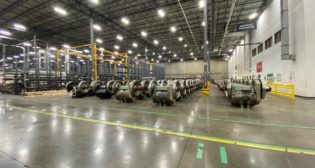
Growing, yet aging—gradually
Written by Carolina Worrell, Senior EditorIn Railinc’s annual review of the North American locomotive fleet, data showed the fleet continued growing in 2014. Locomotives have long service lives, and their average and median ages both increased in 2014.
Key findings
Locomotives continue to join the fleet at a steady rate—this was the fifth consecutive year of growth. At the end of 2014, the locomotive fleet totaled about 37,400, up about 900 units, or 2.4%, from 2013 (Figure 1). The age of the locomotive fleet increased slightly in 2014. Average and median ages both increased 0.1 years in 2014, the fifth consecutive year this occurred.
High-horsepower, six-axle AC locomotives are changing fleet demographics. Those with a horsepower rating of above 4,000 have predominated new additions since the mid-1990s. Those with the highest fuel capacity—more than 4,500 gallons—make up the largest percentage of the fleet.
Locomotive fleet growth characteristics
Since Railinc began reporting on locomotives in 2010, the size of the locomotive fleet has increased each year. Nearly 3,500 new locomotives have joined the North American fleet in the past four years, and the number of locomotives added in 2014 was the highest since 2007 (Figure 2).
Historically, the average age of the fleet and the number of locomotives added to the fleet mirror the economic environment. When the economy is strong and there are more railcars in service—as in the mid-1990s and mid-2000s—the fleet tends to grow. During periods of recession, fewer new locomotives join the fleet.
The shift to AC
DC locomotives make up 69% of the North American fleet, while the share of AC locomotives continues to increase (Figure 3). The percentage of DC units has declined slowly over the past five years as more AC units have joined the fleet. AC locomotives have dominated new additions in the past four years. And, since 2005 and 2006, AC units have made up more than half of all new additions to the locomotive fleet. In the past four years, nearly all new locomotives acquired new were AC units. DC units historically had lower initial costs and lower maintenance costs, though this has shifted recently.
Locomotives with a horsepower rating above 4,000 continue to make up a larger share of the North American fleet—42% in 2014, up three percentage points from 2013.
As a percentage of the fleet, the smallest locomotives—those with up to 2,000 horsepower—held steady in 2014, while those between 2,001 and 4,000 horsepower declined.
This continues the trend of high-horsepower locomotives dominating among additions to the fleet.
Nevertheless, the fleet does continue to add lower-horsepower locomotives, though at generally decreasing rates. These lower-horsepower additions consist of rebuilt locomotives and new units used as switching locomotives.
Locomotives with a horsepower rating of above 4,000 dominate among AC locomotives, which tend to be newer. There are more than twice as many DC diesel locomotives in the North American fleet than AC units. However, DC units are more evenly distributed by horsepower rating, with ratings of 3,000 or less making up the largest share.
Six-axle locomotives make up 69% of the North American fleet. Though the makeup was unchanged in 2014, this share of the overall fleet population has increased over the past three decades, as more six-axle locomotives have joined the fleet. Six-axle locomotives distribute the weight of a locomotive to the rails across more wheels and deliver tractive effort through more wheels and traction motors.
Locomotives with fuel capacity of more than 4,500 gallons make up more than half the North American fleet. This share has grown in recent years, while the share of locomotives with fuel capacity between 3,500 and 4,500 gallons has decreased. This is consistent with the recent trend of the fleet adding new high-horsepower, six-axle locomotives, which have larger fuel tanks.
Road units and switchers
To distinguish locomotives used in road service from those used in switching service, Railinc has applied the following definitions: A road unit has six axles and a horsepower rating greater than 2,500. A switcher has four axles and up to 2,500 horsepower. Road units make up 68% of the North American locomotive fleet, while switchers account for about 23% of the population (Figure 4). Locomotives with four axles and a horsepower rating greater than 2,500 make up 8% of the fleet. However, the industry has shifted away from building this type of locomotive since the mid-1990s.
Industry rules do not require locomotive owners to register their locomotives in the Umler® system, and many locomotives that are in captive service at industrial plants are not registered in Umler®. However, equipment that is used in interchange service, including locomotives, must be registered. As such, the data in this report reflects trends in the locomotive population used in interline exchange.
Railinc is a wholly owned AAR subsidiary. Full report: www.railinc.com/rportal/locomotive-review-2015.



